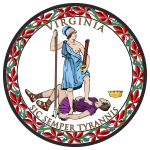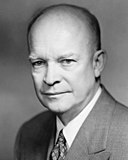| |||||||||||||||||||||||||||||||||
| |||||||||||||||||||||||||||||||||
 County Results
| |||||||||||||||||||||||||||||||||
| |||||||||||||||||||||||||||||||||
| Elections in Virginia |
|---|
 |
The 1956 United States presidential election in Virginia took place on November 6, 1956. Voters chose twelve representatives, or electors to the Electoral College, who voted for president and vice president. For the previous five decades Virginia had almost completely disenfranchised its black and poor white populations through the use of a cumulative poll tax and literacy tests.[2] So restricted was suffrage in this period that it has been calculated that a third of Virginia's electorate during the first half of the twentieth century comprised state employees and officeholders.[2]
This limited electorate allowed Virginian politics to be controlled for four decades by the Byrd Organization, as progressive "antiorganization" factions were rendered impotent by the inability of almost all their potential electorate to vote.[3] Historical fusion with the "Readjuster" Democrats,[4] defection of substantial proportions of the Northeast-aligned white electorate of the Shenandoah Valley and Southwest Virginia over free silver,[5] and an early move towards a "lily white" Jim Crow party[4] meant Republicans retained a small but permanent number of legislative seats and local offices in the western part of the state.[6]
In 1928, the GOP did carry the state's presidential electoral votes due to anti-Catholicism against Al Smith, but it was 1952 before any real changes occurred. In-migration from the traditionally Republican Northeast[7] turned growing Washington, D.C., and Richmond suburbs Republican not just in presidential elections but in congressional ones as well,[8] although the Republicans made no gains in the state legislature where all their few seats remained in the rural west.
1954 saw Virginia's politics severely jolted by Brown v. Board of Education—one of whose component cases Davis v. County School Board of Prince Edward County, originated from a student protest in the state. Despite calls by Governor Thomas B. Stanley for a "calm" and "dispassionate" response, the Byrd machine recognised that segregation could unite most of Virginia's electorate behind it and avert criticism of its other policies.[9] State representative Howard W. Smith played a major role drafting the "Southern Manifesto",[10] which was signed by Virginia's entire congressional delegation, including its two GOP representatives. Although Eisenhower refused to publicly endorse Brown, the fact that he had appointed Brown author Earl Warren meant that there was substantial anger in the Southside, and as in 1948 a "states' rights" ticket,[11] this time headed by Virginian former Commissioner of Internal Revenue T. Coleman Andrews, was filled and placed on the Virginia ballot in mid-September,[12] when a poll said that 28 percent of likely voters would back a states' rights candidate if on the ballot.[13]
Cite error: There are <ref group=lower-alpha> tags or {{efn}} templates on this page, but the references will not show without a {{reflist|group=lower-alpha}} template or {{notelist}} template (see the help page).
- ^ Leip, David. "The Presidents". Retrieved September 27, 2017.
Eisenhower's home state for the 1956 Election was Pennsylvania
- ^ a b Kousser, J. Morgan (1974). The Shaping of Southern Politics: Suffrage Restriction and the Establishment of the One-Party South, 1880–1910. Yale University Press. pp. 178–181. ISBN 0-300-01696-4.
- ^ Key, Valdimer Orlando (1949). Southern Politics in State and Nation. pp. 20–25.
- ^ a b Heersink, Boris; Jenkins, Jeffrey A. (March 19, 2020). Republican Party Politics and the American South, 1865–1968. Cambridge University Press. pp. 217–221. ISBN 978-1107158436.
- ^ Moger, Allen. "The Rift in Virginia Democracy in 1896". The Journal of Southern History. 4 (3): 295–317. doi:10.2307/2191291. JSTOR 2191291.
- ^ Phillips, Kevin P.; The Emerging Republican Majority, pp. 210, 242 ISBN 978-0-691-16324-6
- ^ Heinemann, Ronald L. (2008). Old Dominion, New Commonwealth: A History of Virginia, 1607–2007. Charlottesville: University of Virginia Press. p. 357. ISBN 978-0813927695.
- ^ Atkinson, Frank B. (2006). The Dynamic Dominion: Realignment and the Rise of Two-party Competition in Virginia, 1945–1980. Rowman & Littlefield. ISBN 9780742552098.
- ^ Klarman, Michael (1976). "Why Massive Resistance?". In Webb, Clive (ed.). Southern Politics and the Second Reconstruction. Baltimore: Johns Hopkins University Press. pp. 21–38. ISBN 080181667X.
- ^ Dierenfield, Bruce J. (1987). Keeper of the rules: Congressman Howard W. Smith of Virginia. Charlottesville, Virginia: University Press of Virginia. p. 148. ISBN 0813910684.
- ^ Bartley, Numan V. (1976). Southern Politics and the Second Reconstruction. Baltimore: Johns Hopkins University Press. pp. 87–91.
- ^ "State Slate to be Field for Andrews". Richmond Times-Dispatch. Richmond, Virginia. September 16, 1956. p. 1.
- ^ Latimer, James (September 16, 1956). "Poll Shows Undecided Voters May Swing Virginia Election". Richmond Times-Dispatch. Richmond, Virginia. p. 1.


